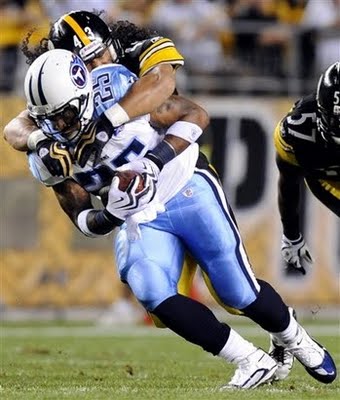False Positives: Troy Polamalu Is the Only DB That Can Tackle
If there’s one thing I’m tired of reading on sports message boards it’s about how defensive backs can’t tackle. According to threads, Ed Reed can’t tackle, Dawan Landry can’t tackle, and neither can Darrell Revis, Asante Samuel, Deangelo Hall, Kerry Rhodes, Charles Woodson, Nnamdi Asomugha, Laron Landry and any other list of defensive backs EXCEPT Troy Polamalu.
There you have it, according to the Sportsworld, TROY POLAMALU IS THE ONLY DEFENSIVE BACK IN THE NFL THAT CAN TACKLE. CONGRATULATIONS TROY YOU FUCKING MADE IT.
Except that’s not true. And even if it were, it might not matter much.
This is the case of when stats and simple arguments (like head to head comparisons) skew a picture. Defensive Backs can become known for not tackling for a few different reasons.
1. They Aren’t Used For Tackling: Defensive Backs are now asked to do a lot. Not only do they cover, they are an integral part of the pass rush, they break up plays, intercept passes and on and on and on. Depending on how a DB is used he may or may not have a high number of tackles. If a DB like Ed Reed or Asante Samuel spends most of their time roaming to intercept passes, tackling may not be their primary role. When it comes to someone like Asomugha who isn’t even being thrown to or when he IS being thrown to doesn’t allow a completion, tackling is often of no consequence because the ball was never caught.
2. They Avoid Missing Tackles. Golden rule for DBs is do.not.miss.any.tackle. If you think of secondaries as last lines of defense then you understand why. If a DB misses a tackle there is a high likelihood that play action continues and results in a gain of several yards or worse a touchdown. To avoid missing a tackle, DBs will often deliver a hit or a simple hard shove out of bounds. To viewers at home the latter may look like a copout, but part of playing the role of DB is make good decisions not just entertaining ones.
3. They Get Burned on National Television. Most people who watch football keep their eye on the ball the entire time. Out of 11 players on the field, viewers probably see 4 at a time on one play, 2 on offense and 2 on defense (QB, Receiver the QB throws to, the defensive player covering the receiver, and the most prominent pass rusher on the play will also usually be in sight). Most viewers don’t see, or at least dont pay attention to, much else. So any time a DB gets burned on a play or missing a tackle they are visible. Same thing for when a DB breaks up a play or delivers a big hit or tackle. That’s why someone like Ed Reed can be both heralded for his play and criticized for tackling ability.
4. Receivers Are Bigger Now. Calvin Johnson, Anquan Boldin, and many other WRs are the same size or bigger than most DBs in the league. Most DBs average somewhere around 6’1 and 210-210 lbs. With WRs like Johnson and Boldin at over 6’4 and weighing over 230 lbs and Tight Ends like Jason Witten and Visanthe Shiancoe also over 6’4 but weighing over 260lbs tackling ain’t no crystal stair. In particular, if a tackle is the 3rd function you perform on just one play.
This is not to say that all these DBs are good tacklers or that there’s no room for improvement. But it is to say that you have to look beyond stats and what plays made highlights to determine what makes a good DB in general and, in a more narrow sense, what makes them good for a particular team. DBs are used differently depending on the team and all are supported by different levels and types of talent. All of that affects how much they tackle and in many cases the likelihood of actually making the high number of those tackles.
At any rate, “does not tackle often” does not equal “cannot tackle.” “Missed a tackle on MNF” does not equal “misses tackles all the time.”
While I have you here, I don’t think I ever linked to this awesome article that Bob Herbert wrote before he left the NY Times a few months back. He talks about some former players and how they mentioned that defensive play (from a fundamental standpoint) had changed for the worse in the NFL.
The N.F.L. has taken some remedial steps, especially in the area of head injuries. But pro football, always violent, is now violent in the extreme, and there is some question as to whether that violent style of play — and the consequences that flow from it — can really be changed. Paul Tagliabue, a former N.F.L. commissioner, told The New Yorker about the comments of a group of former players who had looked closely at the way defensive play has changed. “They raised the idea,” said Tagliabue, “that it was no longer tackle football. It was becoming collision football. The players looked like bionic men.”
Post post post note, my favorite video of a Polamalu tackle.








